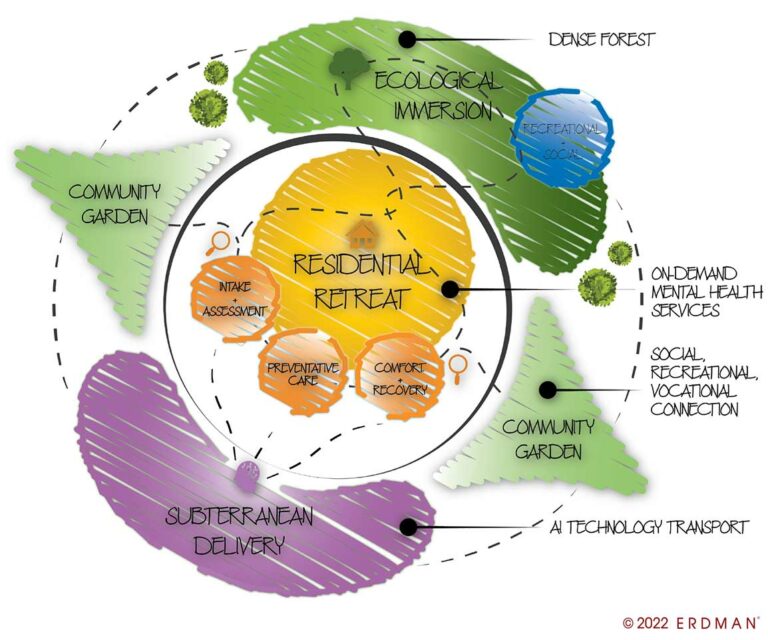
The implementation of new advances in care will be grounded in applying technology in the built environment to maximize efficiency, comfort, and personalization.
Infrastructure must come first. While technological innovations and the metaverse, an interactive virtual-reality space, promise an era of more streamlined and personalized care, we still live in the physical world, in which investing in the right physical and digital infrastructural support will be crucial.
The challenge of making on-demand care more readily available to address lower-acuity needs becomes more pressing by the day, particularly as it concerns mental health. The demand for mental health services continues to increase. And as their resources, capacity, and financial viability suffer, mental health organizations struggle to keep up.
By using design that harmonizes services and facilities in both physical and virtual environments, healthcare systems, hospitals, and mental health care professionals can prepare themselves for the future and better address crucial and high-acuity care.
The metaverse and supportive artificial intelligence offer intriguing possibilities for supporting mental wellness. Modern technology can offer meaningful connections, spot patterns over time, alert professionals to physiological changes that could require immediate care, and provide on-demand mental wellness support.
How effectively these technologies perform will be significantly determined by how well they integrate with built environments.
The Rise of Virtual Care
Telehealth exploded during the early days of the COVID-19 pandemic, and although in-person care has returned, virtual care is not going away – especially for mental health care.
Recent research echoes the trend toward virtual behavioral health care. A RAND study found the significant rise in telehealth use during the height of the pandemic was driven more by people looking for mental health services than care for physical conditions. Another, by SG2, indicates that by 2030 up to 30% of ambulatory visits could be telehealth visits, with many of these in behavioral health.

The Demand for Mental Health Care
A rise in demand is putting new and increasing pressure on existing systems. As the social stigma lifts, more people seek mental health care, straining the capacity of the existing behavioral support network.
Roughly fifty-two percent of behavioral health organizations are seeing the demand for behavioral health services increasing. Meanwhile, capacity is diminishing, compounding the pressure of increased demand. Fifty-four percent of organizations are closing programs. Reductions in annual revenue are causing reduced access to mental health care and many resources are on the brink of disappearing altogether.
The Promise of the Metaverse
Benefits of using the metaverse, and supportive AI, to support mental wellness and behavioral health treatment include:
- Reduced stigma: The metaverse can function as the first point of contact without fear of judgment. Mentors, coaches, and friends are there.
- On-demand access: Automated and available 24-7, access is guaranteed.
- Personalized care: Interactive programs learn and adapt through successive interactions.
- AI’s ability to analyze facial expressions, body language, and speaking patterns serves to increase understanding.
- Supporting crisis management, as well as increasing knowledge of how a mental illness may develop, can lower risk.
- On-demand biomarker analysis can identify potential neurochemical imbalances and facilitate a more exact diagnosis and effective treatment plan.
- Links can be made with environmental quality data to better assess the connection between areas where people live and their likelihood of developing a mental illness with the goal of improving community and individual mental health.
The Challenge of Integrating Virtual and Physical Systems
As caregivers struggle to meet the burgeoning demand for state-of-the-art services, non-traditional thinking and solutions will emerge. Our relationship with the metaverse will be determined in no small part by digital connectivity and understanding how we relate to our existing physical environments, which will give us the insight to unite technology and infrastructure.
Now is the time to invest in the infrastructure needed for future success. Limited access to broadband internet, relative physical isolation, and provider reimbursement models for digital care pose challenges to effective care provision. Key programs such as the Broadband Equity, Access and Deployment Program and the ReConnect Program are part of the solution. Digital transformation is another.

According to a recent Deloitte Center for Health Solutions survey, healthcare organizations recognize “investments in insights and analytics (76%), virtual health services (68%), and cloud (56%) as top priorities today.”
Soon, autonomous wellness will be integrated in the most convenient of places, our homes. A combination of metaverse interactions and AI assessments, compared with baseline properties, can inform and interact with us, delivering insights to support mental wellness. Preventative care, comfort, and recovery options will be readily available. When the need for care exceeds what can be handled at home, hospitals, and other specialized care facilities will be there and well-equipped to address crucial and high-acuity care.
To take full advantage of the possibilities the metaverse affords – and to help providers and patients close gaps in care and avoid some of the unpleasant effects that can accompany immersion in a new virtual environment – an understanding of built environments, and how they facilitate and support the use of innovative technologies, is essential.
- Mental health online: will the metaverse just make everything worse? | Dazed (dazeddigital.com)
- What Role Could Artificial Intelligence Play in Mental Healthcare? (healthitanalytics.com)
- Supporting Physical and Mental Health Through Design (workdesign.com)
Industry Voices—Healthcare is infrastructure, and here’s why we should invest | Fierce Healthcare
- Solving Rural US Health Care Challenges With Frugal Innovation: Low-Costs, High Returns | Health Affairs
- Investment in GCC healthcare digital infrastructure is reaching $1.2BN | Healthcare IT News
- Digital transformation in healthcare | Deloitte Insights
- https://www.rand.org/pubs/external_publications/EP68574.html
- https://www.sg2.com/media-center/press-releases/vizient-analysis-telehealth-data-visits-trend-above-prepandemic-levels/
- https://www.thenationalcouncil.org/news/demand-for-mental-health-and-addiction-services-increasing-as-covid-19-pandemic-continues-to-threaten-availability-of-treatment-options/



